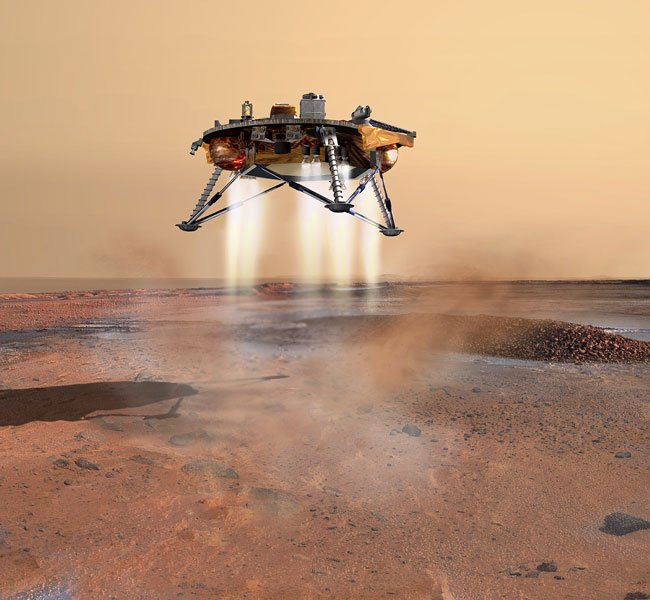Bumpy Road to Mars, Part 1

I visited RichardQuinn's lab at NASA Ames Research Center to learn more about his work onEarth and on Mars. Richard Quinn and John Marshall are both scientists in the Carl Sagan Center at the SETI Institute; they are instrument scientists and team members onNASA's soon-to-land Mars PhoenixLander.
The Phoenix Lander arrives at the redplanet May 25. It will alight on soils near the north polar permanent ice capon an Arctic plain where the Mars Odyssey, currently in orbit, detected highconcentrations of ice just below the topsoil.
Phoenix is a remotely operated laboratory,designed to answer key questions about the history of water on Mars and whetherMars could support life. It's been a longand rocky road to get this lab to Mars in 2008. In 1996, the Russians losta lander which splashed down somewhere off the coast of Chile. In 1999, NASA lost the Mars Polar Lander, and then grounded the similar 2001 Marslander. Then, ESA's Beagle 2 mission failed. It's hard to get to Mars and doscience, as the history of spaceflight attests. Phoenix is well named. Itcarries the heritage, as well as many components, of these prior missions whichall share the same goal: Follow the water in the search for life.
Quinn and Marshall are instrumentscientists for Phoenix. They are both involved with MECA: the Microscopy, Electrochemistry and Conductivity Analyzer. MECA's four tools will examine soil to assesscharacteristics that a gardener or farmer would learn from a soil test, plusseveral more. Three of the tools — a wet chemistry laboratory and two types ofmicroscopes — will analyze samples of soil scooped and delivered by therobotic arm. The fourth tool is mounted near the end of the arm, and has a rowof four small spikes that the arm will push into the ground to examineelectrical conductivity and other properties of the soil. Quinn is aninstrument scientist for wet chemistry analysis, and Marshall for opticalmicroscopy.
RichardQuinn's "day job" is a chemist who develops instrumentation forlanded Mars missions. He's been on a bit of a bumpy road to Mars havingparticipated in the prior missions that did not get to Mars, or failed oncethey arrived. As I noted before, getting to Mars, landing successfully, anddoing good science is hard. Quinn is eager to see the Phoenix Lander safely onMars, and transmitting data to Earth. We all are.
Recently, Igot a look at the wet chemistry instrument in Quinn's lab. Think back to thebeakers and test tubes in your high school chemistry lab. Everything you workedwith was bigger and more fragile than the "beakers" going to Mars.Quinn is working with a small cubical container, about 4 cm on a side with 24tiny sensors embedded in the sides of this high-tech "beaker." Thesensors are small — about the size of a paper punch disk. It's a "lab in ateacup."
MECA carriesfour of these beakers so that Quinn and the team can study four differentsamples. The robotic arm will deliver soil samples to these beakers; water willbe added. By studying the reaction with multiple sensors, Quinn hopes to gaininsight into the history of water on Mars. Are salts present? What is the ph?What dissolves? What does not? And more.
Breaking space news, the latest updates on rocket launches, skywatching events and more!
Quinn isleaving for Tucson, Arizona this week, to join the Phoenix Mission team atmission central near the University of Arizona, home of the Mission PI, PeterSmith. During his stay in Tucson, Quinn and all of the other mission scientistsgo onto martian time to stay synchronized with the up and download of data.Their days will stretch to more than 25 hours, and circadian rhythms will fail.One day, when we actually go to Mars, it will probably be a lot easier toadjust, but living by Mars time on Earth is taxing. He'll work on the missionfor at least 90 days.
Back in California, Quinn is assembling a team to assist him in Earth-based lab analysis of Phoenix data. His lab assistant, Cindy Taylor, is already at work on the project.Beginning in June, two more young scientists will join the team: Kelly Millerand Matthew Finch. Both came to the lab as a part of SETI Institute'sAstrobiology ResearchExperience for Undergraduates program (funded by the NSF and NASA). Lastsummer, Kelly worked in Quinn's lab studying the electrochemical properties ofMartian analog soils using the lab bench version of Quinn's Phoenix Lander wetchemistry instrument. She's just graduated with her degree in chemistry from Scripps College, and is returning to work for Quinn. Earlier this year, Matt spent hisspring break in Quinn's lab learning how to operate the same equipment, andbegins his REU work on June 8. Matt attends College of San Mateo nearby. Forme, it's exciting to see these young scientists starting their careers via ourREU program.
When thewet chemistry data arrives from Mars, the lab team — Cindy, Kelly and Matt — in California will test terrestrial analog soils on the lab bench to assistQuinn with data analysis. They will endeavor to duplicate the results from Marswith samples from Earth using the same equipment in the lab that is installedin the Phoenix Lander. Quinn's Earth-based test lab sits in a smallrefrigerator, waiting for data from Mars, via Tucson, that might reveal whetherthere's life on Mars.
When asked,"What would be the best possible outcome from these experiments?"Quinn replied, "A sample with high salt content and reasonable ph whichwould reveal a history of water, coupled with results from the Thermal EvolvedGas Analyzer that found organics in the soil." Then, you'd have both waterand organics. Perhaps evidence of life?
I askedRichard, "What's next?" and learned that he's already working onconcepts and requirements for an instrument on the ESA Mars lander that's scheduledfor 2013. It's a next generation chemical sensor for analysis of Martianregolith, the next version of a "lab in a teacup."
And, ifthat does not come to fruition, perhaps Quinn will pursue a different avenue.At one time, he planned to teach high school science. He completed acredential, and then diverted to work at the NSF for a couple of years. Then, amasters degree in chemistry and a PhD led him to Mars. He's still interestedin teaching and coaching track, but for now Mars beckons. Can we trace thehistory of water and find evidence of life? Quinn and the other members of thePhoenix Lander team may be able to answer these questions this summer.
Nextweek: Profile ofJohn Marshall, instrument scientist for optical microscopy on MECA.
- Video Player: Mars Reconnaissance Orbiter
- Video Player: Rising to the Red Planet
- Video Player: All Eyes on Mars

Edna DeVore is a science and astronomy educator and the former Director of Education and Public Outreach for the SETI Institute. She earned an undergraduate degree from the University of Pacific followed by a master's degree in instructional technology from San Jose State and a master's in astronomy from the University of Arizona. In 1992, Edna joined the SETI Institute, where she wrote features on space exploration, astrobiology and more, some of which appeared on Space.com. She was among the first principal investigators to propose projects to NASA's Office of Space Science and receive funding for educational programs. Edna went on to work on education and public outreach for NASA's Kepler space telescope and SOFIA flying telescope missions. Edna received numerous awards during her tenure at SETI, including NASA Honor Awards for her work on Kepler and SOFIA, and Aerospace Awareness Award for Women in Aerospace in 2005. Edna retired in 2013.
